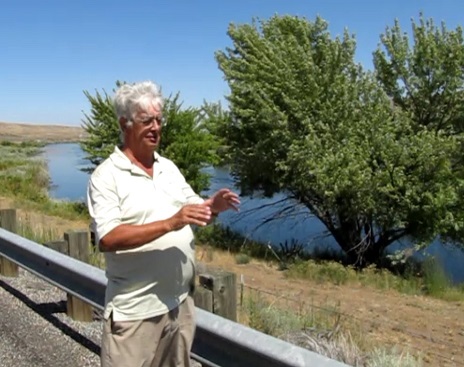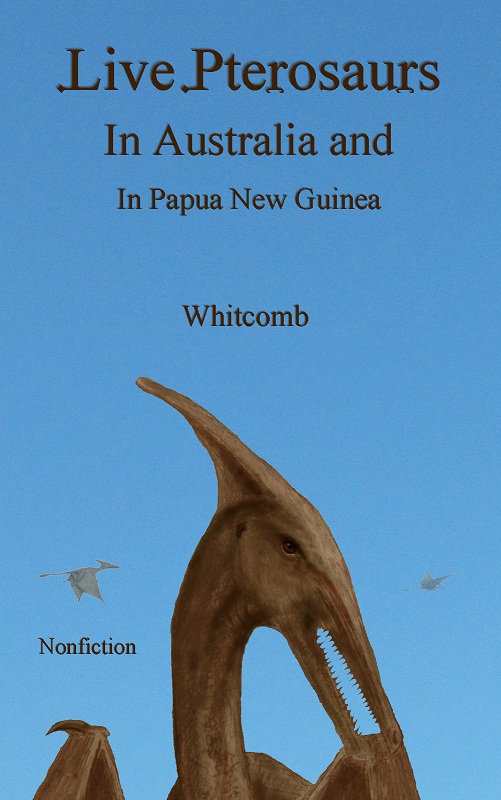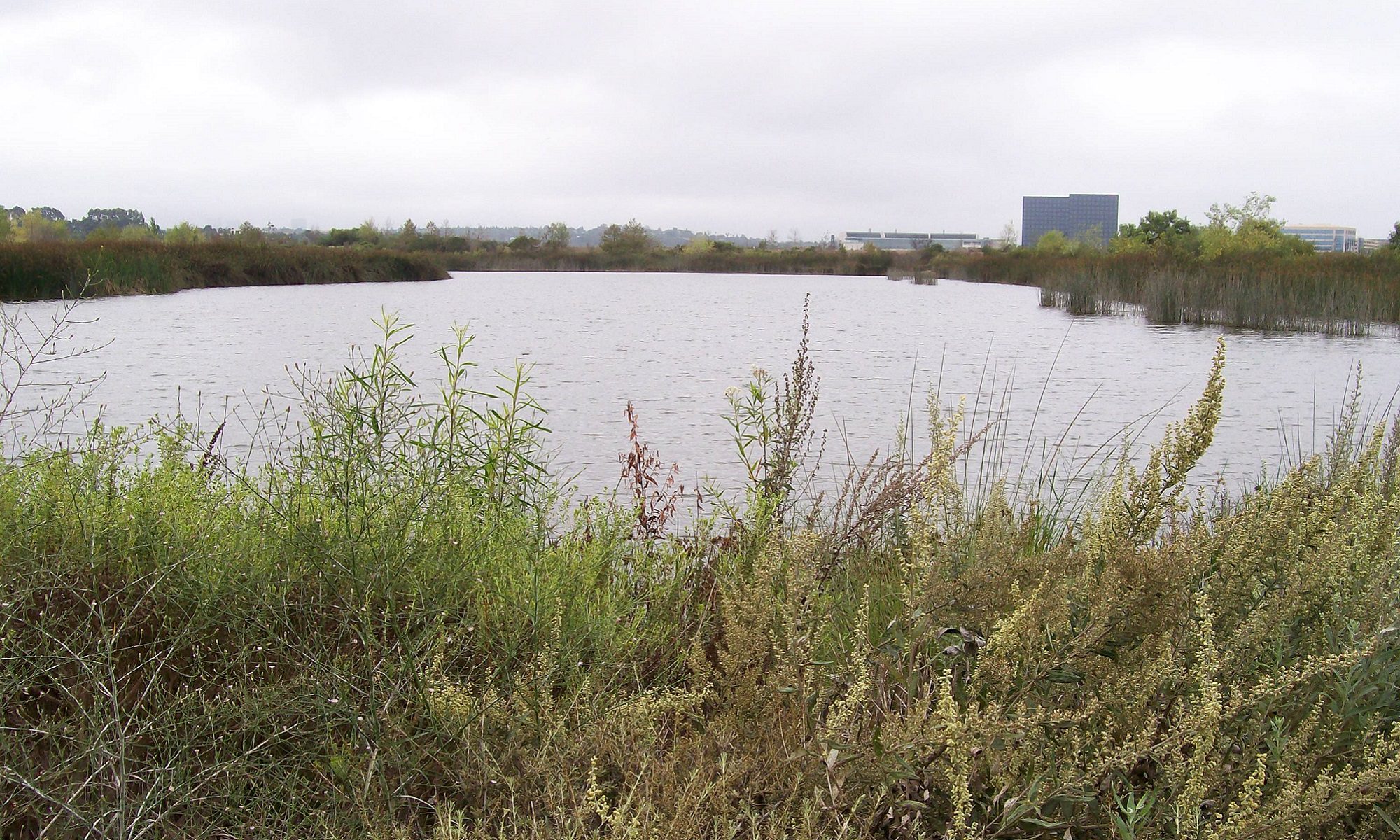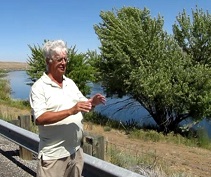It began after the online publication of a photo of a biology professor from Oregon; he was standing by the Yakima River in Washington state. Professor Peter Beach (who has taught at a small college in the Portland area) was being interviewed by me, Jonathan D. Whitcomb (an American cryptozoology author), on August 6, 2014, with Milt Marcy (also from Portland), another cryptozoologist. The controversy related to what Beach and Marcy believe they may have seen: bioluminescent pterosaurs, perhaps even ropens.
 Peter Beach explains how the flying light left this tree at night
Peter Beach explains how the flying light left this tree at night
As this interview became publicized online, another biology professor, this one in Minnesota, became upset and wrote his own blog post, ridiculing the idea of modern pterosaurs. The content of the post by the skeptical professor, however, was weak; it relied on words like “stupid” (in the title) and with “turds” to describe the many writings of a cryptozoologist with whom the Minnesota professor disagrees. I think it would have been more intelligent to rely on reasoning or facts, rather than on bulverism.
The skeptic proclaimed the absence of any evidence for modern pterosaurs (ropen or not) and used his imagination to come up with various faulty motivations for the one that he concentrated on criticizing.
No Evidence for Living Pterosaurs?
Do cryptozoologists really have no evidence for the bioluminescent ropen? It depends on how one defines “evidence.” One thing is certain: There is no evidence of any kind for the universal extinction of all species of pterosaurs.
So what about modern living ones? The great weight of evidence for extant pterosaurs lives in eyewitness testimonies and the statistical analysis of the compiled data from those records. Hoaxes have been eliminated as a significant possibility for the overall case of 128 sighting reports compiled at the end of 2012, by several methods.
In other words, ropen searching and research still lives within the realm of cryptozoology, with no dead or living body of this flying creature to examine in a laboratory or in a zoo; yet scientific methods have been used in examining the eyewitness evidence. Biologists need not worry that cryptozoology is trying to break down a back door or to sneak through a crack in the wall of biology; thus far, it’s just a few scientific tools being borrowed from science, to be used in this narrow field of cryptozoology: Nothing is stolen. When a ropen is caught, dead or alive, it will be brought in through the front door. (Once it’s inside, however, the philosophical case will be opened wide.)
What is a Ropen?
The title of the skeptic’s post was “There are no living pterosaurs, and ‘ropen’ is a stupid fantasy.” So what is the definition for this flying creature whose existence the skeptic-professor in Minnesota disputes? The third edition of my nonfiction book Searching for Ropens and Finding God gives it thus: “A modern pterosaur with Rhamphorhynchoid characteristics.” In other words, a long-tailed featherless flying creature that many American non-scientists would call a “pterodactyl.”
Yet we need to clarify the difference between “Rhamphorhynchoid” and “ropen.” At least as of August 27, 2014, “ropen” refers to a cryptid, and the longer name refers to a type of pterosaur known from fossils. The relationship between them, however, is critical: worldwide, the resemblances are astonishing: featherless flying creatures that have long tails that end with a “diamond” (or a similar description for a tail flange).

On a book cover: sketch of an apparent pterosaur seen by Patty Carson in Cuba
Definition of “Stupid”
One dictionary defined it as “lacking ordinary quickness and keenness of mind.” Take that simply in the literal sense and the biology professor in Minnesota has a problem in making that word useful to his case. A closer look reveals that “stupid” problem.
The cryptozoologist criticized by the professor in Minnesota has worked in his specialty (of sighting reports of apparent pterosaurs) for eleven years, with many thousands of hours of experience with the overall subject; the critic, probably less than ten serious hours. Even if the skeptic in Minnesota were ten times as smart (or less stupid) than the cryptozoologist he criticized, the professor would be at the wrong end of the resulting ratio, 60-to-1. Those are not good odds for the man who teaches biology in Minnesota. This is not to say that the professor is stupid. He is just not likely to be many hundreds of times smarter than the cryptozoologist who has written several nonfiction books on the subject, in addition to a published scientific paper in a recognized peer-reviewed journal of science.
###
Countless eyewitnesses, in many countries across the planet, have pondered what it was they had seen. But ropens continue to fly overhead, continuing to shock humans who had assumed that all pterosaurs had become extinct millions of years ago.
Destination Truth Ropen Episode
I’m thinking about a particular native who was interviewed by Josh Gates, during the Destination Truth expedition of 2007: Fabian. In spite of Fabian’s assurance, however, the expedition team was probably skeptical, at least to some extent, for those visitors to Papua New Guinea were, after all, Americans. They may have thought, “How could a large long-tailed pterosaur be still alive, without the knowledge of any of our scientists?”
There is a species other than a pterosaur that is purported to have intrinsic bioluminescent capability, namely the common barn owl, Tyto Alba.
Evidence for Pterosaurs and Honesty
For modern living pterosaurs, however, we have BOTH physical evidence and eyewitness evidence. The difficulty some persons have with it, however, is that reported eyewitness encounters with living pterosaurs dominate the physical evidence, in both quantity and quality.
.



